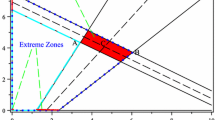Abstract
In this paper, in the framework of the axiomatic approach developed by the author over the past 3 decades, we assume four axioms of “reasonable” choice, which define a rather wide class of problems of multi-criteria selection. To reduce the Pareto set we use numerical information about the preference relation of a decision maker. We propose a method for narrowing the Pareto set using an arbitrary consistent finite set of such information. The method is based on an algorithm that generates a new set of criteria (with a minimum elements number) with respect to which a new Pareto set gives o more precise upper estimate than the initial Pareto set.
Similar content being viewed by others
References
Zakharov, A.O., Pareto-set reduction using compound information of a closed type, Scientific and Technical Information Processing, 2012, vol. 39,Issue 5, pp. 293–302.
Klimova, O.N., Reducing the pareto set on the basis of interrelated information patterns with fuzzy preference relation, Scientific and Technical Information Processing, 2010, vol. 37,Issue 6, pp. 369–376.
Noghin, V.D., The problem of narrowing the Pareto set: paths to the solution, Iskusstvennyi Intellekt i Prinyatie Reshenii, 2008, no. 1, pp. 98–112.
Noghin, V.D., Prinyatie reshenii v mnogokriterial’noi srede: kolichestvennyi podkhod (2 izd., ispr. i dop.) (Desicion Making in a Multi-criteria Environment: a Numerical Approach, 2nd ed., updated), Moscow: FIZMATLIT, 2005.
Noghin, V.D., Reducing the Pareto set based on set-point information, Scientific and Technical Information Processing, 2011, vol. 38,Issue 6, pp. 435–439.
Noghin, V.D., Reducing the Pareto set based on set-point information, Scientific and Technical Information Processing, 2011, vol. 38,Issue 6, pp. 435–439.
Noghin, V.D. and Baskov, O.V., Pareto set reduction based on an arbitrary finite collection of numerical information on the preference relation, Doklady Mathematics, 2011, vol. 83,Issue 3, pp. 418–420.
Rokafellar, R., Convex analysis, Princeton, NJ: Princeton University Press, 1970.
Petrovskii, A.B., Teoriya prinyatiya reshenii (Desicion Making Theory), Moscow: Izdatel’skii tsentr “Akademiya”, 2009.
Schrijver, A., Theory of Linear and Integer Programming, Chichester, UK: Wiley, 1986.
Tamura, K., A Method for Constructing the Polar Cone of a Polyhedral Cone, with Applications to Linear Multicriteria Decision Problems, J. of Optim. Theory and Applications, 1976, vol. 19, no. 4, pp. 547–564.
Author information
Authors and Affiliations
Corresponding author
Additional information
Original Russian Text © V.D. Noghin, 2013, published in Iskusstvennyi Intellekt i Prinyatie Reshenii, 2013, No. 1, pp. 63–69.
About this article
Cite this article
Noghin, V.D. Reducing the pareto set algorithm based on an arbitrary finite set of information “quanta”. Sci. Tech.Inf. Proc. 41, 309–313 (2014). https://doi.org/10.3103/S0147688214050086
Published:
Issue Date:
DOI: https://doi.org/10.3103/S0147688214050086




